|
Cairo University Historical snapshots
Part (2)
Back to part 1>>
The first
Egyptian University's Mansion
The Egyptain University finally came into being and was officially
inaugurated on December 21, 1908. A great ceremony was held at the Legislative
Council Hall, attended by Khedive Abbas II and foreign heads of state. Study
began at the university in the evening of the inauguration day in the form of
general lectures to be given in diverse places such as the Legislative Council
Hall, High Schools Club and Dar AL-Garida.
The first mansion of the EU was a rented mansion belonging to Greek cigarette
mangnate Nestor Gianaclis. (It now houses the administration of the American
University in Cairo)
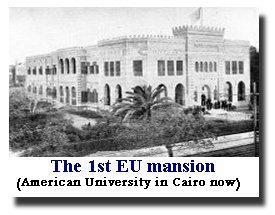
Other EU
mansions
Due to the financial difficulties the University faced during World War I,
the premises were moved to Mohammed Sedky Palace in Al-Falaky Street and other
places.
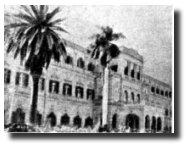 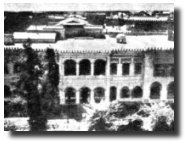 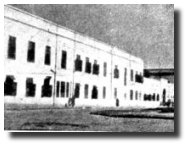
Egyptian
University Missions To Europe:
The Egyptian University clung to its hope in the mission students in Europe.
The first concern of the University was to send some of their distinguished
students to Europe to obtain their Ph.D. and then come back to teach at the
university. The training of professors was seen as so important that the first
mission left in September 1908, before the university began classes. The first
eleven students were divided between arts and sciences. They got E12 monthly for
living expenses and could win a summer travel bonus by doing well. The students
were not to marry. Returning with their doctorates, they were to teach for ten
years or pay back their scholarships. They could start at E400 a year and could
get raises up to E900.
The sending-off of the first mission was almost a national celebration.
Delegations of well-wishers saw them off in Cairo, cheered them at train
stations en route, and feted them in Alexandria.
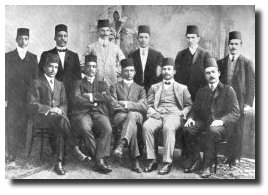 The
first eleven students left in September 1908 to Europe
Seated from right:Mohammed Wali,Mohammed Kamal, Mohammed Tawfik
El-Sawy,
El-Said Kamel, M.Kamel Hussien;
Standing from right: Hassan Al-Dewani, Mansour Fahmi, M. Sadek Goher,
M. Hosny Negm, Tawfik Sedhom.
The
first eleven students left in September 1908 to Europe
Seated from right:Mohammed Wali,Mohammed Kamal, Mohammed Tawfik
El-Sawy,
El-Said Kamel, M.Kamel Hussien;
Standing from right: Hassan Al-Dewani, Mansour Fahmi, M. Sadek Goher,
M. Hosny Negm, Tawfik Sedhom.
|
Page Top |
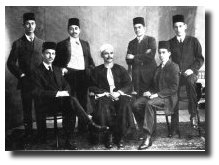 The
second seven students left in 1909 to Europe
Seating
from right: Azmy Khozam, Ahmed Dhef, Hussein
Ramzy
Standing
from right: Yosef Nour al-Din, Hassan Sadek, Mohammed Salem, Ali Tawfik
Shosha
The
second seven students left in 1909 to Europe
Seating
from right: Azmy Khozam, Ahmed Dhef, Hussein
Ramzy
Standing
from right: Yosef Nour al-Din, Hassan Sadek, Mohammed Salem, Ali Tawfik
Shosha
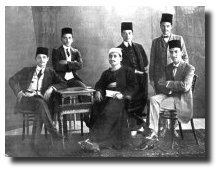 The third five students left in
1910 to Europe
Seating from right: M. Kamel
El-Bindary, Aly Ahmed El-Enany, M. Fahmy Abdel-Latif
Standing from right: Aly Said
Yosef, Mohammed M. El-deep, Abdel-magid A. Khalil
The third five students left in
1910 to Europe
Seating from right: M. Kamel
El-Bindary, Aly Ahmed El-Enany, M. Fahmy Abdel-Latif
Standing from right: Aly Said
Yosef, Mohammed M. El-deep, Abdel-magid A. Khalil
Children
missions to Europe
Aside from a handful of eight-to ten-year-old students (Qasim Amin's son was
one) on an impractical long-term program which produced no professors, twenty
four students went on mission between 1908 and 1925. Twelve went to France,
eight to England, three to Germany, and one to Italy. The "Journey in search of
knowledge" was a venerable Islamic tradition, but these students headed to Paris
and London.
|
Page Top |
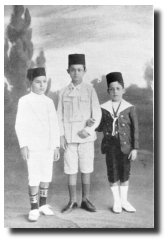 Children
mission to Italy in 1910
From right: Sahab Refat Almath,
Mohammed Kasem Amine, Shadid Hamza
Children
mission to Italy in 1910
From right: Sahab Refat Almath,
Mohammed Kasem Amine, Shadid Hamza
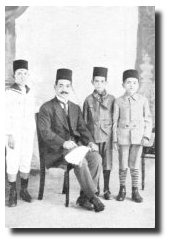 Children
mission to France in 1910
From
right: Aram Stefan, Abdallh Al-Sahen, Hussien Kamel, Abdel-Aziz
Fahmy
Children
mission to France in 1910
From
right: Aram Stefan, Abdallh Al-Sahen, Hussien Kamel, Abdel-Aziz
Fahmy
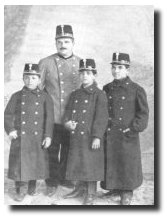 The
third children mission to Austria in 1913
They
wore the uniform during their visit to Empire of Austria From right: Mohammed
Ibrahim Safwat,
Mohamed
Amine Haymen, Mohammed Tawfik Mahran and behind them the officer of the
school
The
third children mission to Austria in 1913
They
wore the uniform during their visit to Empire of Austria From right: Mohammed
Ibrahim Safwat,
Mohamed
Amine Haymen, Mohammed Tawfik Mahran and behind them the officer of the
school
Professors
from Dar al-Ulum and European Professors in the new Egyptian
University:
When the university began, not a single Egyptian could meet all its ideal
criteria for professors: a doctoral degree, a firm grasp of the latest Western
advances in their fields, and ability to teach in Arabic. Pending the return of
mission, the university had to make do with interim staff. The private
university did borrow staff from the Schools of Law for its criminology,
economis, and law programs. Dar al-Ulum and the School for Qadis provided the
university, between 1908 and 1925, with at least nine professors, five were
teaching at the school of Qadis, and one at the police school. Hefni Nasif, an
educator, judge, and man of letters who sat in the university council, taught
Arabic literature at the university for a year, and several other Dar al-Ulumis
stayed only briefly. But four from Dar al-Ulm also taught at the university for
at least five years., long enough to have a real impact: Rafat Ismail in
geography and ethnography, Muhammed al-Mahdi in Arabic literature, and Muhammed
al-Khudari and Abd al-Wahhab Najjar in Islamic history.
Not all the interim
local professors were from Dar al-Ulum, Ahmed Zaki was a Cairo law graduate who
had taught himself Islamic history.Jurjji Zaydan (Greek Orthodox editor of
al-Hilal) also learned Isalmic historyon his own. he said that:"the true history
of the nation is the history of its civilization and culture, not the history of
its wars and conquests in the manner of the earlier Arab historians of Islam.
The other source of interim professors was Europe. The European professors
fall into two categories: those who lectured in French or English on topics
unrelated to the Middle East, and orientalists who lectured in Arabic and
Islamic subjects. France, Italy, England, and to a lesser extent Germany, all
jockeyed for the influence at the private university.
Percy White is the
only individual Englishman who occupied the chair of English literature. He
arrived in 1911 and taught into 1920s with a three year interruption during the
war.
France and Italy were the two main contenders for cultural influence at
the university. With Fuad's friend Victor Emmanuel III on the throne, the
university easily secured official Italian support. Italy supplied orientalists
because it had no Italian literature course to match those in English and
French. Ignazio Guidi, Calo Nallino and David Meloni taught on ancient Near
East.
Fuad was an Italophile first, but he also liked the French. France had
been influential in Egypt since Napoleon's brief occupation. So, several
Frenchmen held the chair of literature in turn. Louis Clement, of the university
of Lille, took up the post in 1912 and occupied it into the 1920s. French
faculty representation peaked in 1912-1913 when young orientalists Louis
Massignon and Gaston Wiet arrived to replace the outsed Italians.
|
Page Top |
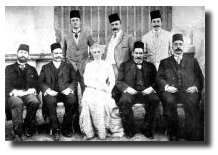 Staff of
Egyptian University in 1911
Seated
from right: Hefni Nasif Bic, Saber Sabry Pasha, Miss Couvreur, Ismail Hassanien
Pasha, Mr. Nallino
Standing
from right: Mr. Albert Bovelli, Mr. Sisson and professor of English literature
Staff of
Egyptian University in 1911
Seated
from right: Hefni Nasif Bic, Saber Sabry Pasha, Miss Couvreur, Ismail Hassanien
Pasha, Mr. Nallino
Standing
from right: Mr. Albert Bovelli, Mr. Sisson and professor of English literature
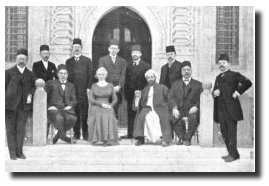 Staff of
Egyptian University in 1913
Seated
from right: Hefni Nasif Bic, Al-shikh Mohammed Al-Khodary, Miss Mlle Couvreur,
Ismail Rafat
Standing
from right: Mr. July, Louis Massignon, Carlo Nallino, Mr. Miller, Charl Sison,
Littmann
Staff of
Egyptian University in 1913
Seated
from right: Hefni Nasif Bic, Al-shikh Mohammed Al-Khodary, Miss Mlle Couvreur,
Ismail Rafat
Standing
from right: Mr. July, Louis Massignon, Carlo Nallino, Mr. Miller, Charl Sison,
Littmann
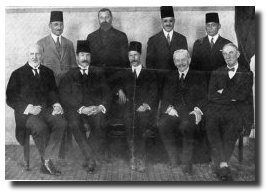 Vice
Rector Ahmed Lutfi al-Sayyid and the faclulty of the Egyptian University, c.
1924
Seated,
from the left: Vladimir Golenscheff, Mansour Fahmi, Ahmed Lutfi al-Sayyid, Louis
Clement, Percy White
Standing
from left: Ahmed Dayf, Paul Girard, Taha Husayn, Ali
al-Inani
Vice
Rector Ahmed Lutfi al-Sayyid and the faclulty of the Egyptian University, c.
1924
Seated,
from the left: Vladimir Golenscheff, Mansour Fahmi, Ahmed Lutfi al-Sayyid, Louis
Clement, Percy White
Standing
from left: Ahmed Dayf, Paul Girard, Taha Husayn, Ali
al-Inani
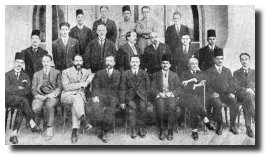 Professors of Faculty of Arts
Seated
from right: Charls Couienter, Dr. Taha Husayn, Henry Loran, Ahmed Fahmi
al-Amrousy, Henry Gregoar, Emil Breih, George Houstlie, Paul Grandour, Dr. Gorgy
Soubhy
Seated
second row: Ahmed Ibrahim, Mr. Wanmo, Oskar Grogan, Andrea Liberton, Jolinteef
Clemann, Dr. Mohamed Sabry
Standind
third row from right: Nouteh, Klergeh, Dopp
Professors of Faculty of Arts
Seated
from right: Charls Couienter, Dr. Taha Husayn, Henry Loran, Ahmed Fahmi
al-Amrousy, Henry Gregoar, Emil Breih, George Houstlie, Paul Grandour, Dr. Gorgy
Soubhy
Seated
second row: Ahmed Ibrahim, Mr. Wanmo, Oskar Grogan, Andrea Liberton, Jolinteef
Clemann, Dr. Mohamed Sabry
Standind
third row from right: Nouteh, Klergeh, Dopp
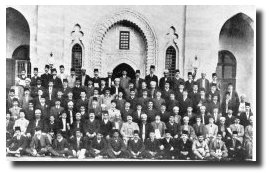 Egyptian
University, Islamic Civilization Class 1909
Egyptian
University, Islamic Civilization Class 1909
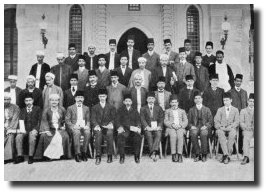 Egyptian
University, Ancient Civilization 1909, iProfessor Ahmed Kamal (with goat) seated
in center,
Taha
Husayn is third the left in the second row
Egyptian
University, Ancient Civilization 1909, iProfessor Ahmed Kamal (with goat) seated
in center,
Taha
Husayn is third the left in the second row
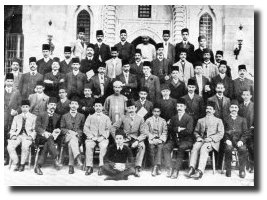 Egyptian
University, French Language Class in 1909
| Page
Top |
Back to part 1|
Egyptian
University, French Language Class in 1909
| Page
Top |
Back to part 1|
|